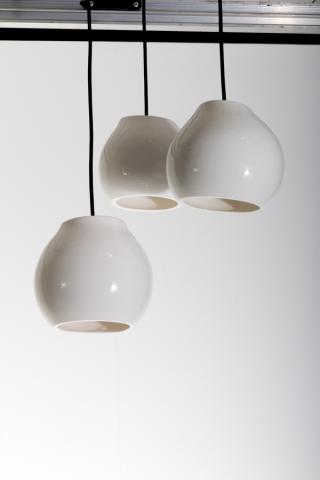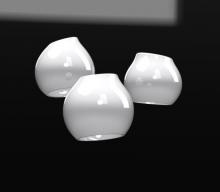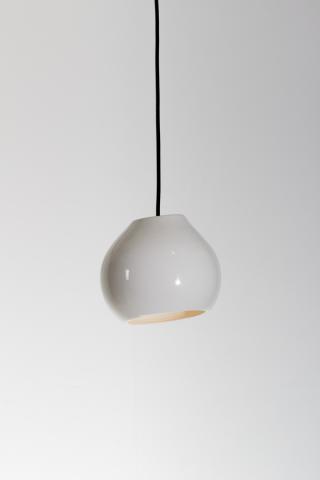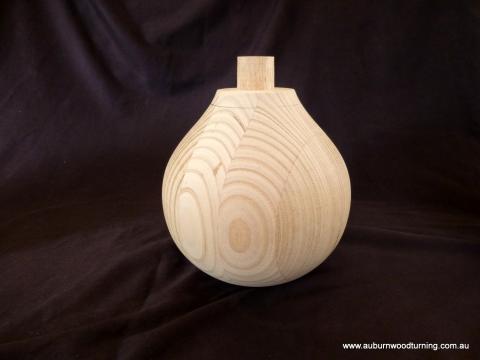Casting Light on a Brilliant Illusion
Industrial designer Ryan Penning’s job seemed impossible to us at first glance. He was after lighting patterns for a tertiary project at RMIT. His drawings, perfect in detail, showed 3 forms, none of which were suitable for turning due to the asymmetrical design. Or so it seemed….
 The human eye can sometimes play tricks and in studying the drawings further, an illusion became apparent. Have a go at seeing this for yourself. Are these regular round forms?
The human eye can sometimes play tricks and in studying the drawings further, an illusion became apparent. Have a go at seeing this for yourself. Are these regular round forms?

In reality, the base shape of these forms is perfectly symmetrical and can easily be turned in the lathe. It is the angles of the cuts at the top and bottom of these shapes that create the perceptual anomaly. The finished form has an ‘S’ shape deceiving the eye, drawing attention away from the principle round form from which the design was made.
It can be seen below that the full form of the shape was a regular and round before edge cutting.

This interesting project is well worth sharing and when we asked Ryan, he willingly agreed to  an interview. In it he explains the development of the design concept, manufacturing process and introduces others that were involved in the creation of these beautiful pendant lights.
an interview. In it he explains the development of the design concept, manufacturing process and introduces others that were involved in the creation of these beautiful pendant lights.
Q. What was the purpose of the lighting project?
The Slight Pendants were originally the result of a design studio run as part of the RMIT Industrial Design course; it was led by Copper ID. They were extremely helpful and supportive during the studio. The first prototypes had room for improvement, so I contacted Steve at the woodturners to get patterns for new moulds made.
Q. What was the inspiration behind the design?
I believe inspiration is a continuous process, the Slight Pendants developed from the sketching process. The real development happened when I began lathing prototypes in foam. This allowed me to work out the subtleties of the form. Each of the craftsmen/women I worked with also added their own subtle touches to the final product, an aspect that I value.
Q. What material was used for the final product and why did you choose this?
 The final product is slip cast from earthenware clay. Originally porcelain was used, but to combat the shrinkage and deformation of porcelain we switched to earthenware. As the lights are glazed, switching clays was no problem visually. I decided to use ceramics early on as I was interested in exploring the slip casting process.
The final product is slip cast from earthenware clay. Originally porcelain was used, but to combat the shrinkage and deformation of porcelain we switched to earthenware. As the lights are glazed, switching clays was no problem visually. I decided to use ceramics early on as I was interested in exploring the slip casting process.
Q. What was the manufacturing process after the patterns were turned?
I took the patterns and created plaster moulds from them, having solid timber patterns means I can recreate these moulds many times. I did some post processing on the patterns myself, mainly sanding the top and bottoms to the required angles. After casting the prototypes myself,  I handed the moulds over to SaJo. They manage everything from casting to firing.
I handed the moulds over to SaJo. They manage everything from casting to firing.
Q. What challenges did you face in the design and manufacture process?
The biggest challenges I faced were due to being new to both the lathing and slip casting processes. I like to produce designs myself, but my skills are not that great so I decided to enlist the help of a woodturner and a ceramist, SaJo Ceramics. Both of which are great to work with.
Q. Are these lights for sale?
Yes, they are for sale. They are available in white gloss and white matte glazes. Interested people can contact me at
About Ryan Pennings
Ryan is an industrial designer in Melbourne. His interest is algorithmic design and 3D printing. He contrasts these areas with more traditional batch production methods.
Find out more about Ryan at ryanpennings.com
Other Contacts
Sajo Ceramics
Copper ID
Workshopped Exhibition
